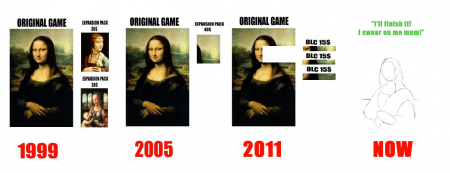Selling Overhead
Is what this Gamasutra article called the recent trend in game development to sell “the things that usually end up on the game studio’s cutting room floor”. It’s talking about things like Early Access, selling the game while it’s being developed, and mostly about selling the “Prologue” to Metal Gear Solid V and selling access to Double Fine’s Amnesia Fortnight.
First of all, I don’t think it’s really surprising in this age where Publishers are mostly going the way of the dinosaurs and more developers retaking control of their creations and trying to hit the audience directly, saving money while still trying to make hiqh-quality (i.e. expensive) titles. The money has to come from somewhere.
The writer stresses the Double Fine and Metal Gear Solid V angle a lot, Double Fine selling access to their prototypes (things we usually couldn’t, and probably shouldn’t see) and Metal Gear Solid being split into (at least) two parts with the first one serving as “prologue” whose content might or might not later also appear in the full game, but I would like to point out two counter examples and say that, once again, when satisfaction is concerned, it’s all about expectations.
The current customer expects that when she pays 60$ for a new game it will contain at least 10-20 hours of meaningful gameplay. Whether this is reasonable considering what we pay for movies, music, etc… is a different discussion – this is what we currently expect. In the days of the first StarCraft it was reasonable to sell a main game for 60$ and then an expansion with more missions and story for 30$. We then evolved the model of selling the main game for 60$ and tiny bundles of story/gameplay/extras for 5-15$ and lately we’ve also added alphafunding. Some of these models seem weird but, again, it’s all about expectations. And also honesty and transparency. (Here come the two examples).
- Decent Early Access Games/Developers – Look at Mojang, Vlambeer and all the others that decided to go the alphafunding/early access route but did it candidly. Mojang sold Minecraft from the very early (and sometimes broken versions) but they were honest about it. They said the game is in development, it might break, and you’re actually paying for the game’s development as it is being developed. The customers were promised that, they were promised that the game will be updated and improved and they won’t have to pay more despite the initial entry fee always increasing. And fucking hell, that model works for them. Vlambeer went with Steam Early Access for Nuclear Throne. They were upfront in saying that the game is in development, it will be cheaper after it’s done and there will be no sales or bundles until release. They said that this is only for those who want to support the developers during development. And they live-stream development and upload a new build every week. Which is awesome. They promised specific things and they deliver on what the customers expect from that.
- Stoic went a bit of a different route with The Banner Saga. They started from a Kickstarter campaign, raised funds and used those funds to start development. Roughly a year later, they released Factions, the Free-To-Play competitive version of the game featuring their beautiful art but mostly consisting of just the combat aspect of the game. They did that because they saw that development will take longer than previously expected and they wanted to put out something that people can play. But, mostly, they did that so they could get more help (than just backers) with fine tuning the combat aspect (the main game loop in The Banner Saga) and bring it to a mirror polish, thus making the final game better for everyone. But, they released it free to play. Meaning, you could play the “no-campaign” version of the game for free and if you wanted to, you could sink some money into it to fund development of the full game. They told gamers what to expect and they delivered on those promises, honestly and ethically. Then, another year later, you could buy the campaign-full, complete version of the game for a very competitive price of 25$.
Conclusion: I don’t think there is a right or wrong way to develop or sell your game. The only wrong thing is no fulfilling your customer’s expectation. Yes, sometimes those expectations are not up to you and you can roll with it or sit in the corner and cry. But, if you notice it, the only times gamers rise in uproar about how a game is sold/played/whatever is when it doesn’t fulfill expectations. I don’t know exactly how the Metal Gear Solid V thing is going to work but if Ground Zeros is selling for 30$ and The Phantom Pain will sell for 60$ and Ground Zeros won’t deliver at least half the satisfaction of The Phantom Pain and/or The Phantom Pain will actually contain some, half and especially most or all of the gameplay of Ground Zeros, you can definitely expect an uproar.
Posted in Gaming, IT, Practice, Programming, Thinking Out Loud by Eran with comments disabled.
